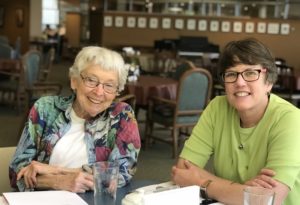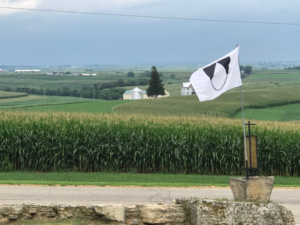
While we may have leaders, whose congregational titles read “Superior” or “Superior General” or “President” or, as in the case of my congregation, “Prioress,” much of post-Vatican II religious life is founded on collaboration not hierarchy. According to Carol Gilligan and others, women tend to build webs of relationships rather than arenas of competition (In a Different Voice: Psychological Theory and Women’s Development [Harvard University Press], 1982). A sister in my own community, Kaye Ashe, O.P., Ph.D. (may she rest in peace) nuanced this a bit when she argued that “effective leaders will appreciate diversity and thrive on meaning derived from multiple sources” (The Feminization of the Church [Sheed & Ward, 1997], 149). Or as Helen Keller well-noted, “Alone we can do so little, together we can do so much.” Alone I can do so little. With deep humility I recognize that fact. And with even more humility, I have invited Sister Scholars who have published or taught in the field of Science or Scripture or Ethics to form a loose advisory committee to offer guidance throughout this project.
Last June, I drove to our motherhouse in rural Southwest Wisconsin to meet with one of my advisors, Sr. Jean McSweeney, O.P., Ph.D. in Chemistry. As I drove under a cloudless cerulean sky, I pondered the conversation to come. What questions would I ask? How do I frame this project? What if Jean isn’t all that interested? What is she thinks I’ve bitten off more than I can chew? But the deepest and scariest question, what might happen to my faith as I delve more deeply into science?
Ruminating on these questions, I looked out beyond Interstate 90. I saw the greening of the fields on either side. The chartreuse of new grass just peeking up over the soil. The Kelly green of corn fields. The distant dark green of cedars and cottonwoods. The whole land had become a 64 box of Crayola crayons in shades of green. And the thought that came to me from deep within was, “Beauty. And Beauty is God’s middle name.”
I answered my own anxiety. I know why those plants are green. I taught photosynthesis once (a long time ago!). I know the science behind it all. But knowing that chlorophyll is the substance that captures the sun’s energy and turns it into plant food in no way diminishes its beauty. There is knowledge for the mind; there is beauty for the soul. And there is no contradiction.
With this comforting insight, I met Sr. Jean who was not only delighted in my project but saw it was a meaningful, important contribution to both scholarship and praxis. From her twenty-years of study in this area, she shared references, articles, and insights, confirming for me that collaboration not only gives us company on the journey but provides wisdom only experience can offer. So, while I cannot invite all of you to the table as advisors, I do welcome your suggestions for further reading. For as our blessed Kaye Ashe famously wrote:
The search for self,
for wisdom, for love,
for truth, for justice,
for God—
is strenuous and unending.
We need good companions in order to persevere in it.
In good company, in a community of conviction,
the quest never loses its relevance, its urgency, or its savor.

A note to commentators: I am a Catholic Christian scholar for whom the Gospel directs not only my teaching, but my actions and hopefully my speech. I look forward to your insights, but I ask that in the spirit of Christian charity and courteous discourse you write with love and civility. Uncharitable or discourteous speech has no place in thoughtful dialogue.
“Let no evil talk come out of your mouths, but only what is useful for building up, as there is need, so that your words may give grace to those who hear” (Eph 4:29).
In the Dominican Spirit of disputatio, this is a wonderful way to stretch us and get the conversations ruminating, roaming and reflecting within all of us. Levels of understanding can merge and flow together or separate as needs be, but if all is carried out in this spirit our ideas can more easily plow through the murkiness and hold the wonder yet to come.
Indeed, Pat, the spirit in which we discuss and differ determines the success of our conversations.
I am always made more whole and happy reading your insights on the relation between science and religion.
I learn from the best! Your own work on astronomy inspires my interest.
As strong as it already is, I think perhaps your faith will be deepened and made even stronger by what you discover, Laurie! Mine, too! God is the source of both science and seeking, after all. Gratitude to you and Rhonda for sharing the journey with us!
It’s good to be in a “community of conviction”!
Always remembering companions on our journey include trees, four leggeds ,winged and more. Creation holds wisdom to untie the knots in life and it has the binding force to tie the gift of life and death together.
Well said!
One of the Rhineland mystics – can’t remember if it was Eckhart, Tauler or Suso – used an image of God as a woman continually giving birth. It gave me a sense of Love at the heart of the Universe(s) and the energy of all creation. I don’t know how that fits with Jesus and how we have understood the Incarnation, but wonder about a sense of God-Life in creation from the first speck of atom or dust or ? I think it is our brother Thomas who wrote: “Where God is not, nothing is”. I have trouble thinking of… Read more »
Ilia Delio, Christ in Evolution (Orbis, 2008), writes “The cosmic Christ signifies the eternal kenosis of God’s self-sacrificing love which manifests itself within the evolutionary movement of creation and culminates by personalizing itself in the incarnation. The cosmos, or universe, is evolving toward its full realization in Christ, the Omega, who is the energizing principle underlying the process of evolution.” (83). I think this is a helpful way to think of the Incarnation within the larger cosmological and evolutionary story. Bonaventure and Don Scotus, two good Franciscans , also understood the Incarnation as always part of God’s creative plan.